Sony Ericsson C2005, C2004 User Manual

User guide
Xperia™ M dual
C2004/C2005
Contents
Getting started............................................................................... |
6 |
Android™ – what and why?............................................................... |
6 |
Overview............................................................................................ |
6 |
Assembly........................................................................................... |
7 |
Turning the device on and off............................................................ |
9 |
Locking and unlocking the screen..................................................... |
9 |
Setup guide...................................................................................... |
10 |
Accounts and services..................................................................... |
10 |
Getting to know your device........................................................ |
12 |
Using the keys................................................................................. |
12 |
Using the touchscreen..................................................................... |
12 |
Battery.............................................................................................. |
13 |
Lock screen..................................................................................... |
16 |
Home screen.................................................................................... |
16 |
Taking a screenshot......................................................................... |
19 |
Accessing and using applications................................................... |
19 |
Status and notifications................................................................... |
21 |
Accessing settings........................................................................... |
23 |
Typing text....................................................................................... |
23 |
Customising your device................................................................. |
26 |
Memory............................................................................................ |
28 |
Using a headset .............................................................................. |
29 |
Internet and messaging settings...................................................... |
30 |
Controlling data usage..................................................................... |
31 |
Selecting networks for data traffic................................................... |
32 |
Mobile network settings................................................................... |
32 |
Downloading applications............................................................ |
34 |
Downloading applications from Google Play™............................... |
34 |
Downloading applications from other sources................................ |
34 |
Calling.......................................................................................... |
35 |
Making calls..................................................................................... |
35 |
Receiving calls................................................................................. |
36 |
Ongoing calls................................................................................... |
37 |
Using the call log............................................................................. |
37 |
Forwarding calls............................................................................... |
38 |
Restricting calls................................................................................ |
38 |
Multiple calls.................................................................................... |
38 |
Conference calls.............................................................................. |
39 |
Voicemail.......................................................................................... |
39 |
2 |
|
This is an Internet version of this publication. © Print only for private use.
Emergency calls............................................................................... |
40 |
Contacts....................................................................................... |
41 |
Transferring contacts....................................................................... |
41 |
Searching and viewing contacts...................................................... |
42 |
Adding and editing contacts............................................................ |
43 |
Favourites and groups..................................................................... |
44 |
Sending contact information............................................................ |
44 |
Avoiding duplicate entries in the Contacts application................... |
44 |
Backing up contacts........................................................................ |
45 |
Messaging and chat..................................................................... |
46 |
Using text and multimedia messaging............................................. |
46 |
Text and multimedia message options............................................ |
47 |
Instant messaging and video chat................................................... |
48 |
Email............................................................................................. |
49 |
Setting up email............................................................................... |
49 |
Sending and receiving email messages.......................................... |
49 |
Email preview pane.......................................................................... |
50 |
Organising your email messages..................................................... |
51 |
Email account settings..................................................................... |
52 |
Gmail™............................................................................................ |
52 |
Music............................................................................................ |
53 |
Transferring music to your device................................................... |
53 |
Listening to music............................................................................ |
53 |
WALKMAN home screen ................................................................ |
54 |
Playlists............................................................................................ |
55 |
Sharing music.................................................................................. |
56 |
Enhancing the sound....................................................................... |
57 |
Visualiser ......................................................................................... |
57 |
Recognising music with TrackID™.................................................. |
57 |
Music Unlimited online service........................................................ |
59 |
FM radio....................................................................................... |
60 |
FM radio overview............................................................................ |
60 |
Favourite radio channels.................................................................. |
61 |
Sound settings................................................................................. |
61 |
Camera......................................................................................... |
62 |
Taking photos and recording videos............................................... |
62 |
Face detection................................................................................. |
63 |
Using Smile Shutter™ to capture smiling faces.............................. |
63 |
Adding the geographical position to your photos........................... |
64 |
General camera settings.................................................................. |
64 |
Still camera settings......................................................................... |
65 |
Video camera settings..................................................................... |
68 |
3 |
|
This is an Internet version of this publication. © Print only for private use.
Photos and videos in Album........................................................ |
70 |
Viewing photos and videos.............................................................. |
70 |
Sharing and managing photos and videos...................................... |
71 |
Editing photos with the Photo editor application............................. |
72 |
Photo albums................................................................................... |
73 |
Viewing your photos on a map........................................................ |
74 |
Movies.......................................................................................... |
76 |
Watching videos in the Movies application..................................... |
76 |
Transferring video content to your device....................................... |
77 |
Managing video content.................................................................. |
77 |
Video Unlimited............................................................................ |
78 |
Video Unlimited service................................................................... |
78 |
Web browser................................................................................ |
79 |
Browsing the web............................................................................ |
79 |
Connectivity................................................................................. |
80 |
Connecting to wireless networks..................................................... |
80 |
Sharing content with DLNA Certified™ devices.............................. |
83 |
NFC.................................................................................................. |
85 |
Bluetooth® wireless technology...................................................... |
87 |
Connecting your device to a computer........................................... |
89 |
Scanning barcodes with the NeoReader™ application................... |
92 |
Smart Connect................................................................................. |
92 |
Synchronising data on your device.............................................. |
94 |
About synchronising data on your device....................................... |
94 |
Synchronising with Google™ services............................................ |
94 |
Synchronising your corporate email, calendar and contacts.......... |
94 |
Maps and locations...................................................................... |
96 |
Location services and sources........................................................ |
96 |
Using GPS....................................................................................... |
96 |
Google Maps™................................................................................ |
97 |
Calendar and alarm clock............................................................ |
98 |
Calendar........................................................................................... |
98 |
Alarm clock...................................................................................... |
98 |
Support and maintenance.......................................................... |
101 |
Updating your device..................................................................... |
101 |
Backup and restore application..................................................... |
102 |
Resetting your device.................................................................... |
103 |
Locking and protecting your device.............................................. |
104 |
Finding your device........................................................................ |
106 |
Support application....................................................................... |
107 |
Recycling your device.................................................................... |
107 |
4 |
|
This is an Internet version of this publication. © Print only for private use.
Reference................................................................................... |
108 |
Status and notification icons overview.......................................... |
108 |
Application overview...................................................................... |
109 |
Important information................................................................. |
111 |
Important information leaflet.......................................................... |
111 |
Limitations to services and features.............................................. |
111 |
Legal information........................................................................... |
111 |
5
This is an Internet version of this publication. © Print only for private use.

Getting started
Android™ – what and why?
Your Xperia™ from Sony runs on the Android™ platform. Android™ devices can perform many of the same functions as a computer and you can customise them to your own needs. For example, you can add and delete applications, or enhance existing applications to improve functionality. On Google Play™ you can download a range of applications and games from a constantly growing collection. You can also integrate applications on your Android™ device with other applications and with online services that you use. For example, you can back up your contacts, access your different email accounts and calendars from one place, keep track of your appointments, and engage in social networking.
Android™ devices are constantly evolving. When a new software version is available and your device supports this new software, you can update your device to get new features and the latest improvements.
Your Android™ device is pre-loaded with Google™ services. To get the most out of the provided Google™ services, you should have a Google™ account and sign in to it when you first start your device. You also need to have Internet access to use many of the features in Android™.
New software releases may not be compatible with all devices.
Overview
1Front camera lens
2Proximity/Light sensor
3Ear speaker
4Power key
5Volume/Zoom key
6Camera key
7Microphone 1
8Touchscreen
6
This is an Internet version of this publication. © Print only for private use.
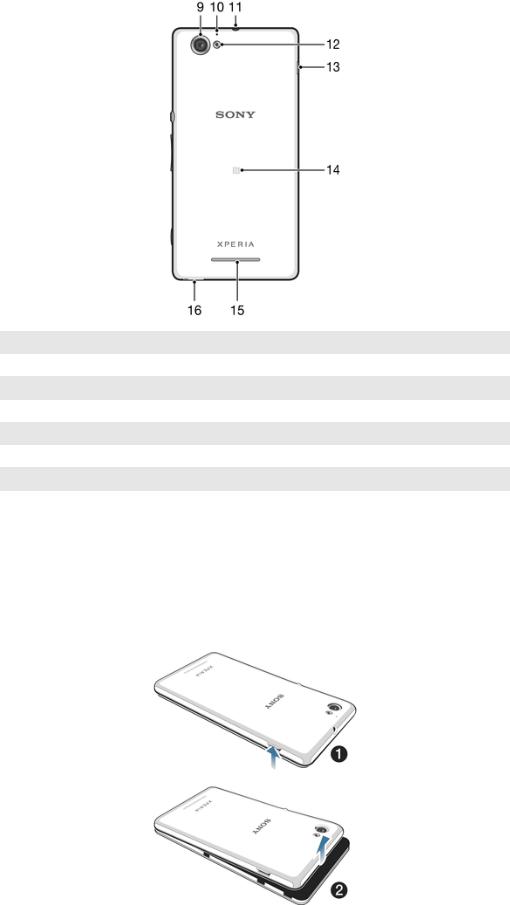
9Main camera lens
10Microphone 2
11Headset jack
12Camera light
13Port for charger/USB cable
14NFC™ detection area
15Speaker
16Strap hole
Assembly
A protective plastic sheet is attached to the screen. You should peel off this sheet before using the touchscreen. Otherwise, the touchscreen might not function properly.
To remove the back cover
7
This is an Internet version of this publication. © Print only for private use.

1Insert a thumbnail into the opening, as shown in the illustration, then lift up the
side of the cover.
2Remove the whole cover.
To insert the memory card
1Remove the back cover.
2Insert the memory card into the memory card slot, with the gold-coloured contacts facing down.
The memory card may not be included at purchase in all markets.
To insert the micro SIM card
•Remove the battery cover, then insert the micro SIM card into its slot with the gold-coloured contacts facing down.
You must use a micro SIM card for your device to work correctly. Some standard-sized SIM cards allow you to detach an integrated micro SIM card. Once you detach the micro SIM card from the standard-sized SIM card, you cannot reattach it and use the standard-sized SIM card again. If you do not have a micro SIM card, or if your current SIM card does not contain a detachable micro SIM card, contact your network operator for information on how to collect or exchange your SIM card.
8
This is an Internet version of this publication. © Print only for private use.

To attach the back cover
1Place the back cover over the back of the device.
2Press down the sides of the cover until you hear clicking noises.
Turning the device on and off
To turn on the device
1Press and hold down the power key until the device vibrates.
2 If your screen goes dark, briefly press the power key to activate the screen.
3To unlock the screen, swipe up or down on the screen.
4 |
Enter your SIM card PIN when requested, then select OK. |
5 |
Wait a while for the device to start. |
|
Your SIM card PIN is initially supplied by your network operator, but you can change it later |
|
from the Settings menu. To correct a mistake made while entering your SIM card PIN, tap . |
|
To turn off the device |
1 |
Press and hold down the power key until the options menu opens. |
2 |
In the options menu, tap Power off. |
3Tap OK.
It may take a while for the device to shut down.
Locking and unlocking the screen
When your device is on and left idle for a set period of time, the screen darkens to save battery power and locks automatically. This lock prevents unwanted actions on the touchscreen when you are not using it. When you buy your device, a basic screen swipe lock is already set. In other words, you have to swipe up or down on the screen to unlock it. You can later change the security settings and add other kinds of locks. See Setting a screen lock on page 105.
9
This is an Internet version of this publication. © Print only for private use.
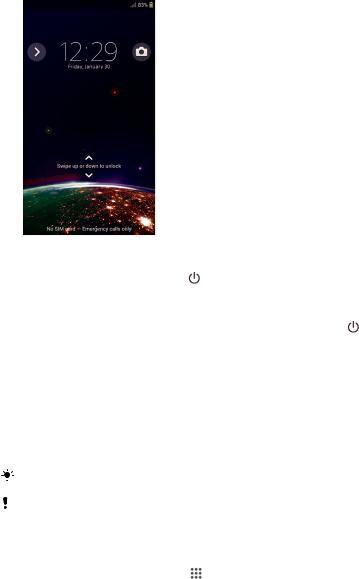
|
To activate the screen |
• |
Briefly press the power key . |
|
To lock the screen |
• |
When the screen is active, briefly press the power key . |
Setup guide
The first time you start your device, a setup guide opens to help you configure basic settings, sign in to some accounts, and personalise your device. For example, if you have a Sony Entertainment Network account, you can sign in to it and start enjoying music, videos and games from the Sony Entertainment Network on your device. Or you can create a new account directly on your device.
You can also access the setup guide later from the Settings menu.
Sony Entertainment Network with Video Unlimited and Music Unlimited is not available in every market. Separate subscription required. Additional terms and conditions apply.
To access the setup guide manually
1 From the Home screen, tap .
2 Tap Settings > Setup guide.
Accounts and services
Sign in to your online service accounts from your device to get easy access when you're on the move. For example, you can integrate contacts from your Google™ account into your Contacts, so you have everything in one place. You can sign up to new online services from your device as well as from a computer.
Google™ account
Having a Google™ account is key to using a range of applications and services with your Android™ device. You need a Google™ account, for example, to use the Gmail™ application in your device, to chat with friends using Hangouts™, and to synchronise the calendar application on your device with your Google Calendar™. You also need a Google™ account to download applications and games, music, movies and books from Google Play™.
Microsoft® Exchange ActiveSync® account
Synchronise your device with your corporate Microsoft® Exchange ActiveSync® account. This way, you keep your work email, contacts and calendar events with you at all times.
10
This is an Internet version of this publication. © Print only for private use.
Facebook™ account
Facebook™ is a social networking service that connects you with friends, family and colleagues around the world. Set up Facebook to work on your device so that you can stay in touch from anywhere.
11
This is an Internet version of this publication. © Print only for private use.

Getting to know your device
Using the keys
Back
•Go back to the previous screen
•Close the on-screen keypad, a dialog box, an options menu, the Notification panel, or an application
Home
•Go to the Home screen
Task
•Tap to open a window showing your most recently used applications and a small apps bar
Using the touchscreen
To open or highlight an item
•Tap the item.
To mark or unmark options
•Tap the relevant checkbox or the switch beside the option name.
Zooming
The zoom options available depend on the application you are using.
To zoom
•Place two fingers on the screen at once and pinch them together (to zoom out) or spread them apart (to zoom in).
When you use two fingers on the screen to zoom, it is only possible to zoom if both fingers are within the zoomable area. If you, for example, want to zoom in on a photo, make sure that both fingers are within the photo frame area.
Scrolling
Scroll by moving your finger up or down on the screen. On some web pages you can also scroll to the sides.
Dragging or flicking will not activate anything on the screen.
12
This is an Internet version of this publication. © Print only for private use.
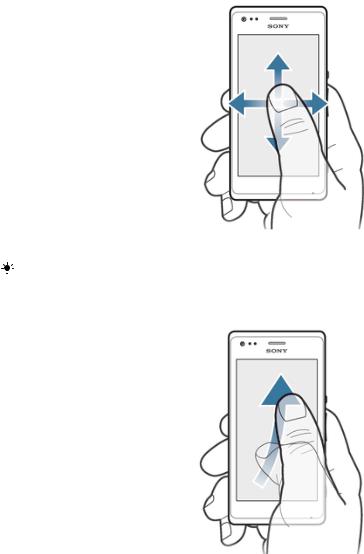
To scroll
•Drag or flick your finger in the direction you want to scroll on the screen.
To scroll more quickly, flick your finger in the direction you want to go on the screen.
To flick
•To scroll more quickly, flick your finger in the direction you want to go on the screen. You can wait for the scrolling movement to stop by itself, or you can stop it immediately by tapping the screen.
Sensors
Your device has sensors that detect both light and proximity. The light sensor detects the ambient light level and adjusts the brightness of the screen accordingly. The proximity sensor turns the touch screen off during voice calls when your ear is close to the screen. This prevents you from unintentionally activating other functions on your device when you are engaged in a call.
Battery
Charging the battery
Your battery is partly charged when you buy your device. It may take a few minutes before the battery icon  appears on the screen when you connect the charger cable to a power source, such as a USB port or a charger. You can still use your device while it is charging. Charging your device over a long period of time, for example, overnight, does not damage the battery or the device.
appears on the screen when you connect the charger cable to a power source, such as a USB port or a charger. You can still use your device while it is charging. Charging your device over a long period of time, for example, overnight, does not damage the battery or the device.
13
This is an Internet version of this publication. © Print only for private use.

To charge your device
1 Plug the charger into a power outlet.
2 Plug one end of the USB cable into the charger (or into the USB port of a computer).
3 Plug the other end of the cable into the micro USB port on your device, with the USB symbol facing up. The notification light illuminates when charging begins.
4When the device is fully charged, disconnect the cable from your device by pulling it straight outwards. Make sure not to bend the connector.
If the battery is completely discharged, it may take a few minutes before the notification light illuminates and the charging icon  appears.
appears.
Battery notification light status
Green |
The battery charge level is greater than 90% |
|
|
Flashing red |
The battery level is low |
|
|
Orange |
The battery is charging and the battery charge level is less than 90% |
|
|
To check the battery level
1From your Home screen, tap .
2Find and tap Settings > About phone > Status > General > Battery level.
Improving battery performance
The following tips can help you improve battery performance:
•Charge your device often. This will not affect the lifetime of the battery.
•Downloading data from the Internet is power consuming. When you're not using the Internet, you can save power by disabling all data connections over mobile networks. This setting does not prevent your device from transmitting data over other wireless networks.
•Turn off Bluetooth® and Wi-Fi® connections when you don't need these features. You can turn them on and off more easily from the Notification panel by dragging down the status bar.
•Use the STAMINA mode and Low battery mode features to reduce battery consumption. You can select the power saving mode that best suits the way you use your device. You can also customise the settings of each power saving mode.
•Set your synchronisation applications (used to synchronise your email, calendar and contacts) to synchronise manually. You can also synchronise automatically, but increase the synchronisation intervals.
•Check the battery usage menu in your device to see which applications use the most power. Your battery consumes more power when you use video and music streaming applications, such as YouTube™. Some applications downloaded from Google Play™ may also consume more power.
•Close and exit applications that you are not using.
•Lower the screen display brightness level.
14
This is an Internet version of this publication. © Print only for private use.

•Turn off your device or activate the Airplane mode setting if you are in an area with no network coverage. Otherwise, your device repeatedly scans for available networks, and this consumes power.
•Use a Sony™ original handsfree device to listen to music. Handsfree devices demand less battery power than your device's own loudspeakers.
•Keep your device in standby whenever possible. Standby time refers to the time during which your device is connected to the network and is not being used.
•Disable any live wallpaper.
|
To access the battery usage menu |
1 |
From your Home screen, tap . |
2 |
Find and tap Settings > Power management > Battery usage. |
Using STAMINA mode
Activate the STAMINA mode feature to pause your Wi-Fi® connection, data traffic and several power consuming applications when your screen is inactive. When STAMINA mode is active, you can still receive phone calls, and text and multimedia messages. You can also set up an applications list to allow some applications to keep running when your screen is inactive. Once the screen becomes active again, all paused functions are resumed.
To activate STAMINA mode
1 Drag the status bar downwards, then tap .
2 Find and tap Power management.
3Drag the slider beside STAMINA mode to the right, then tap Activate.  appears in the status bar when STAMINA mode is activated.
appears in the status bar when STAMINA mode is activated.
|
To deactivate STAMINA mode |
1 |
From your Home screen, tap . |
2 |
Find and tap Settings > Power management. |
3Tap  next to STAMINA mode.
next to STAMINA mode.
To change the settings for STAMINA mode
1 From your Home screen, tap .
2Find and tap Settings > Power management.
3 To open the settings menu, tap STAMINA mode. 4 Add or remove applications, as desired.
5When you're finished, tap Done.
Estimating the standby time of your device
Standby time refers to the amount of time the battery can last when your device is connected to the network but is not in active use, for example, to receive or make phone calls. STAMINA mode, when activated, continuously evaluates the remaining standby time, which can vary depending on how you use your device. STAMINA mode is more effective in lengthening the standby time if you keep the screen of your device locked. If you rarely lock the screen, you may not see much improvement in battery performance.
When you use your device for the first time, the estimated standby time may not be accurate since there is no previous usage history to estimate from.
To view the estimated standby time 1 From your Home screen, tap .
2Find and tap Settings > Power management.
Using Low battery mode
You can activate the Low battery mode feature to save power when the battery level is low. This feature helps you to adjust the settings for screen brightness, data traffic and the vibrate function so that you can reduce battery consumption.
15
This is an Internet version of this publication. © Print only for private use.

To activate Low battery mode
1 From your Home screen, tap .
2Find and tap Settings > Power management.
3Tap  next to Low battery mode, then tap Activate.
next to Low battery mode, then tap Activate.
|
To deactivate Low battery mode |
1 |
From your Home screen, tap . |
2 |
Find and tap Settings > Power management. |
3Tap  next to Low battery mode.
next to Low battery mode.
To change the settings for Low battery mode
1 From your Home screen, tap .
2Find and tap Settings > Power management.
3 To open the settings menu, tap Low battery mode. 4 Adjust the settings as desired.
5When you're finished, tap  .
.
Lock screen
The lock screen is the screen that you see when the device is locked but the screen is active. The lock screen can have up to five panes and you can add one widget to each pane. You can then access these widgets from the lock screen. For example, you can add the Calendar widget and an email widget so that you can gain quicker access to these applications.
The Clock widget is located by default in the middle pane of the lock screen.
To add a widget to the lock screen
1To activate the screen, briefly press the power key .
2 Swipe inwards from the top left area of the screen until  appears, then tap it. 3 If required, enter your PIN code, pattern or password to unlock the screen.
appears, then tap it. 3 If required, enter your PIN code, pattern or password to unlock the screen.
4Find and tap the widget that you want to add.
5Follow the on-screen instructions, if necessary, to finish adding the widget.
|
To remove a widget from the lock screen |
1 |
To activate the screen, briefly press the power key . |
2 |
Touch and hold the widget that you want to remove, then drag it to . |
|
To move a widget on the lock screen |
1 |
To activate the screen, briefly press the power key . |
2Touch and hold the widget that you want to move, then drag it to the new location.
Home screen
The Home screen is your gateway to the main features on your device. You can customise your Home screen with applications, widgets, shortcuts, folders, themes, and wallpaper.
The Home screen extends beyond the regular screen display width, so you need to flick left or right to view content in all of the Home screen's panes.
 shows which part of the Home screen you are in. You can set a pane as the main Home screen pane, and add or delete panes.
shows which part of the Home screen you are in. You can set a pane as the main Home screen pane, and add or delete panes.
16
This is an Internet version of this publication. © Print only for private use.
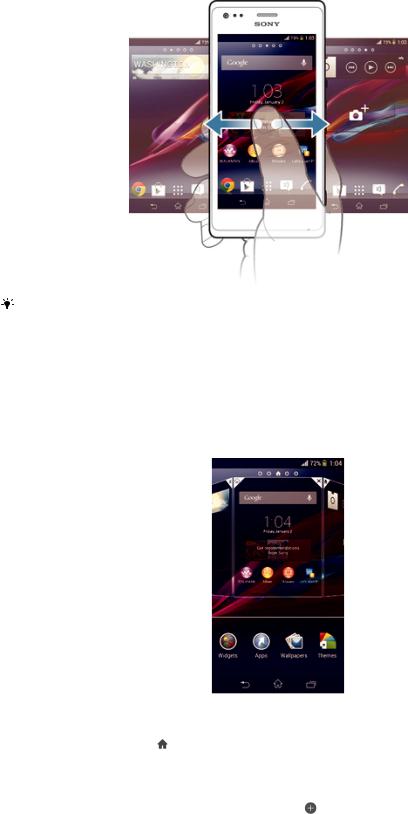
The items in the bar at the bottom of the screen are always available for quick access.
To go to the Home screen
•Press  .
.
To browse the Home screen
•Flick right or left.
To set a pane as the main Home screen pane
1 |
Touch and hold an empty area on your Home screen until the device vibrates. |
2 |
Flick left or right to browse to the pane that you want to set as your main Home |
|
screen pane, then tap . |
|
To add a pane to your Home screen |
1 |
Touch and hold an empty area on your Home screen until the device vibrates. |
2 |
Flick left or right to browse the panes, then tap . |
To delete a pane from your Home screen
1Touch and hold an empty area on your Home screen until the device vibrates.
2Flick left or right to browse to the pane that you want to delete, then tap  .
.
Widgets
Widgets are small applications that you can use directly on your Home screen. For example, the “WALKMAN” widget allows you to start playing music directly.
17
This is an Internet version of this publication. © Print only for private use.

Some widgets are resizable, so you can expand them to view more content or shrink them to save space on your Home screen.
To add a widget to the Home screen
1Touch and hold an empty area on your Home screen until the device vibrates, then tap Widgets.
2 |
Find and tap the widget that you want to add. |
|
To resize a widget |
1 |
Touch and hold a widget until it magnifies and the device vibrates, then release |
|
the widget. If the widget can be resized, for example, the Calendar widget, |
|
then a highlighted frame and resizing dots appear. |
2Drag the dots inward or outward to shrink or expand the widget.
3To confirm the new size of the widget, tap anywhere on the Home screen.
Rearranging your Home screen
Customise the appearance of your Home screen and change the features that you can access from it. Change the screen background, move items around, create folders, and add shortcuts and widgets.
Customisation options
When you touch and hold an empty area of your Home screen, the following customisation options appear:
Add widgets to your Home screen.
Add applications and shortcuts.
Set a wallpaper for your Home screen.
Set a background theme.
To view customisation options from the Home screen
•Touch and hold an empty area on your Home screen until the device vibrates and customisation options appear at the bottom of the screen.
To add a shortcut to your Home screen
1Touch and hold an empty area on your Home screen until the device vibrates and the customisation menu appears.
2In the customisation menu, tap Apps.
3Scroll through the list of applications and select an application. The selected application gets added to the Home screen.
In step 3, alternatively, you can tap Shortcuts and then select an application from the list available. If you use this method to add shortcuts, some of the applications available allow you to add specific functionality to the shortcut.
To move an item on the Home screen
•Touch and hold the item until it magnifies and the device vibrates, then drag the item to the new location.
To delete an item from the Home screen
•Touch and hold an item until it magnifies and the device vibrates, then drag the item to  .
.
To create a folder on the Home screen
•Touch and hold an application icon or a shortcut until it magnifies and the device vibrates, then drag and drop it on top of another application icon or shortcut.
18
This is an Internet version of this publication. © Print only for private use.

To add items to a folder on the Home screen
•Touch and hold an item until it magnifies and the device vibrates, then drag the item to the folder.
To rename a folder on the Home screen
1Tap the folder to open it.
2 Tap the folder's title bar to show the Folder name field.
3Enter the new folder name and tap Done.
Changing the background of your Home screen
Adapt the Home screen to your own style using wallpapers and different themes.
To change your Home screen wallpaper
1 Touch and hold an empty area on your Home screen until the device vibrates.
2Tap Wallpapers and select an option.
To set a theme for your Home screen
1 Touch and hold an empty area on your Home screen until the device vibrates.
2Tap Themes, then select a theme.
When you change a theme, the background also changes in some applications.
Taking a screenshot
You can capture still images of any screen on your device as a screenshot. Screenshots you take are automatically saved in Album.
To take a screenshot
1Press and hold down the power key and the volume down key simultaneously until you hear a clicking sound.
2To view the screenshot, drag the status bar fully downwards.
Accessing and using applications
Open applications from shortcuts on your Home screen or from the Application screen.
Application screen
The Application screen, which you open from your Home screen, contains the applications that come pre-installed on your device as well as the applications you download.
The Application screen extends beyond the regular screen width, so you need to flick left and right to view all content.
To open the Application screen
•From your Home screen, tap  .
.
To browse the Application screen
•From the Application screen, flick right or left.
19
This is an Internet version of this publication. © Print only for private use.

To open the Application screen menu
•When the Application screen is open, drag the left edge of the screen to the right.
To add an application shortcut to the Home screen
1From the Application screen, touch and hold an application icon until the screen vibrates, then drag the icon to the top of the screen. The Home screen opens.
2Drag the icon to the desired location on the Home screen, then release your finger.
Opening and closing applications
To open an application
•From your Home screen or the Application screen, tap the application.
To close an application
•Press  .
.
Some applications are paused when you press  to exit, while other applications may continue to run in the background. In the first case, the next time you open the application, you can continue where you left off. Remember that some applications may cause data connection charges when they are running in the background, for example, social networking services.
to exit, while other applications may continue to run in the background. In the first case, the next time you open the application, you can continue where you left off. Remember that some applications may cause data connection charges when they are running in the background, for example, social networking services.
Recently used applications window
You can switch between recently used applications from this window. You can also open small apps.
To open the recently used applications window
• Press  .
.
|
Using small apps |
|
From the recently used applications window, you can get quick access to several |
|
small apps at any time using the small apps bar. A small app only takes up a small |
|
area of your screen. So you can interact with a small app and another application at |
|
the same time on the same screen. |
|
To open the small apps bar |
• |
Press . |
|
To open a small app |
1 |
To make the small apps bar appear, press . |
2 |
Tap the small app that you want to open. |
You can open several small apps at the same time.
To close a small app
•Tap  on the small app window.
on the small app window.
To move a small app
•When the small app is open, touch and hold the top left corner of the small app, then move it to the desired location.
To minimise a small app
•When the small app is open, touch and hold the top left corner of the small app, then drag it to the right edge or to the bottom edge of the screen.
20
This is an Internet version of this publication. © Print only for private use.

To rearrange the small apps in the small apps bar
•Touch and hold a small app and drag it to the desired position.
To remove a small app from the small apps bar
•Touch and hold a small app, then drag it to  .
.
To restore a previously removed small app
1 |
Open the small apps bar, then tap |
. |
||
2 |
Touch and hold the small app that you want to restore, then drag it into the |
|||
|
small apps bar. |
|
|
|
|
To download a small app |
|
|
|
1 |
From the small apps bar, tap |
, then tap and tap . |
||
2 |
Search for the small app that you want to download, then follow the |
|||
|
instructions to download it and complete the installation. |
|||
|
To add a widget as a small app |
|
|
|
1 |
To make the small apps bar appear, press . |
|||
2 |
Tap |
> > . |
|
|
3Select a widget.
4Enter a name for the widget, if desired, then tap OK.
Application menu
You can open a menu at any time when you are using an application. The menu will look different depending on which application you are using.
To open a menu in an application
•While using the application, press  .
.
A menu is not available in all applications.
Rearranging your Application screen
Move the applications around on the Application screen according to your preferences.
To arrange applications on the Application screen
1To open the Application screen menu, drag the left edge of the Application screen to the right.
2 |
Select the desired option under SHOW APPS. |
|
To move an application on the Application screen |
1 |
To open the Application screen menu, drag the left edge of the Application |
2 |
screen to the right. |
Make sure that Own order is selected underSHOW APPS. |
|
3 |
Touch and hold the application until it magnifies and the device vibrates, then |
|
drag it to the new location. |
|
To uninstall an application from the Application screen |
1 |
To open the Application screen menu, drag the left edge of the Application |
2 |
screen to the right. |
Tap Uninstall. All uninstallable applications are indicated by . |
3Tap the application that you want to uninstall, then tap Uninstall.
Status and notifications
The status bar at the top of your screen shows what's going on in your device. To the left you get notifications when there is something new or ongoing. For example, new message and calendar notifications appear here. The right side shows the signal strength, battery status, and other information.
21
This is an Internet version of this publication. © Print only for private use.

The Notification panel allows you to adjust basic settings on your device, for
example, Wi-Fi®, Bluetooth®, data traffic, and sound. You can also open the settings menu from the Notification panel to change other settings.
Checking notifications and ongoing activities
You can drag down the status bar to open the Notification panel and get more information. For example, you can use the panel to open a new message or view a calendar event. You can also open some applications that run in the background, such as the music player.
To open the Notification panel
•Drag the status bar downwards.
To close the Notification panel
•Drag the tab at the bottom of the Notification panel upwards.
To take action on a notification
•Tap the notification.
To dismiss a notification from the Notification panel
•Place your finger on a notification and flick left or right.
22
This is an Internet version of this publication. © Print only for private use.

To clear all notifications from the Notification panel
• Tap Clear.
|
Setting your device from the Notification panel |
|
You can open the settings menu from the Notification panel to adjust device quick |
|
settings. For example, you can turn on Wi-Fi®. |
|
To open the device settings menu from the Notification panel |
1 |
Drag the status bar downwards. |
2 |
Tap . |
|
To adjust sound settings from the Notification panel |
1 |
Drag the status bar downwards. |
2 |
Tap . |
|
To control the Bluetooth® function from the Notification panel |
1 |
Drag the status bar downwards. |
2 |
Tap . |
|
To control the Wi-Fi® function from the Notification panel |
1 |
Drag the status bar downwards. |
2 |
Tap . |
|
To enable or disable data traffic from the Notification panel |
1 |
Drag the status bar downwards. |
2 |
Tap . |
|
Accessing settings |
|
View and change settings for your device from the Settings menu. The Settings menu |
|
is accessible from both the Notification panel and the Application screen. |
|
To access your device settings |
1 |
From your Home screen, tap . |
2 |
Tap Settings. |
|
You can also drag the status bar downwards on the Home screen and tap to access your |
|
device settings. |
Typing text
You can select from a number of keyboards and input methods to type text containing letters, numbers and other characters. You can type in two or three Latin languages without switching keyboards. The Xperia™ international keyboard detects the language and predicts the words as you type.
On-screen keyboard
You can enter text with the on-screen QWERTY keyboard by tapping each letter individually, or you can use the Gesture input feature and slide your finger from letter to letter to form words. If you prefer to use a smaller version of the on-screen keyboard and input text using only one hand, you can activate the one-handed keyboard instead.
You can select up to three languages for text input. The keyboard detects the language that you are using and predicts the words for that language as you type. Some applications open the on-screen keyboard automatically, for example, email and text messaging applications.
23
This is an Internet version of this publication. © Print only for private use.
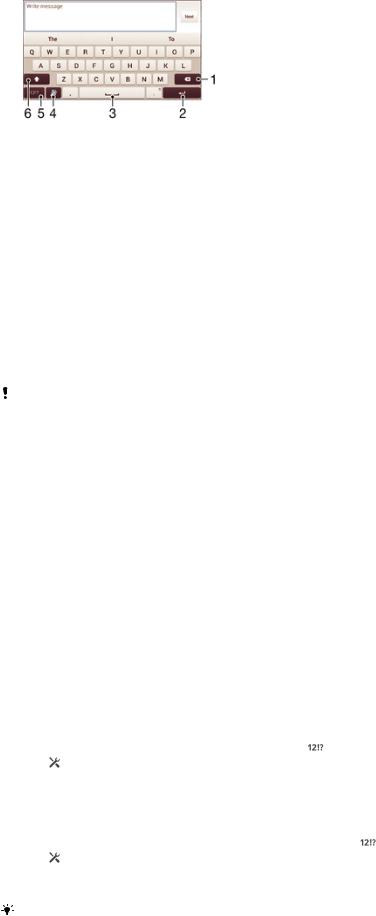
1Delete a character before the cursor.
2Enter a carriage return or confirm text input.
3Enter a space.
4Personalise your keyboard. This key disappears after the keyboard is personalised.
5Display numbers and symbols. For even more symbols, tap  .
.
6Switch between lower-case  , upper-case
, upper-case  and caps
and caps  . For some languages, this key is used to access extra characters in the language.
. For some languages, this key is used to access extra characters in the language.
To display the on-screen keyboard to enter text
•Tap a text entry field.
To use the on-screen keyboard in landscape orientation
•When the on-screen keyboard is displayed, turn the device sideways.
You may need to adjust the settings in some applications to enable landscape orientation.
To enter text character by character
1To enter a character visible on the keyboard, tap the character.
2To enter a character variant, touch and hold a regular keyboard character to get a list of available options, then select from the list. For example, to enter "é", touch and hold "e" until other options appear, then, while keeping your finger pressed on the keyboard, drag to and select "é".
To enter a period
• After you enter a word, double-tap the space bar.
To enter text using the Gesture input function
1 When the on-screen keyboard is displayed, slide your finger from letter to letter to trace the word that you want to write.
2 After you finish entering a word, lift up your finger. A word suggestion appears based on the letters that you have traced.
3If the word that you want does not appear, tap  to see other options and select accordingly. If the desired option does not appear, delete the entire word and trace it again, or enter the word by tapping each letter individually.
to see other options and select accordingly. If the desired option does not appear, delete the entire word and trace it again, or enter the word by tapping each letter individually.
To change the Gesture input settings
1 When the on-screen keyboard is displayed, tap .
2Tap , then tap Keyboard settings > Text input settings.
3To activate or deactivate the Gesture input function, mark or unmark the
Gesture input checkbox.
|
To use the one-handed keyboard |
1 |
Open the on-screen keyboard in portrait mode, then tap . |
2 |
Tap , then tap One-handed keyboard. |
3To move the one-handed keyboard to the left side or right side of the screen, tap  or
or  accordingly.
accordingly.
To return to using the full on-screen keyboard, tap  .
.
24
This is an Internet version of this publication. © Print only for private use.
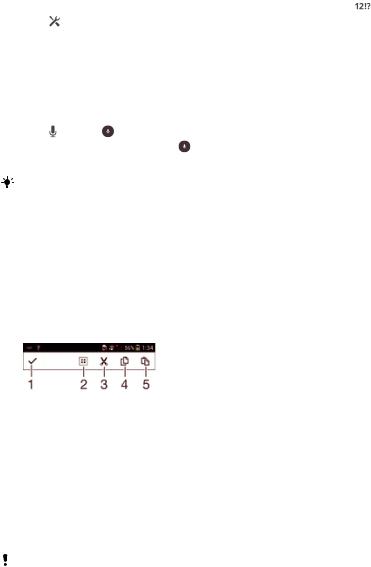
|
Entering text using voice input |
|
When you enter text, you can use the voice input function instead of typing the |
|
words. Just speak the words that you want to enter. Voice input is an experimental |
|
technology from Google™, and is available for a number of languages and regions. |
|
To enable voice input |
1 |
When you enter text using the on-screen keyboard, tap . |
2 |
Tap , then tap Keyboard settings. |
3Mark the Google voice typing key checkbox.
4Tap  to save your settings. A microphone icon
to save your settings. A microphone icon  appears on your on-screen keyboard.
appears on your on-screen keyboard.
To enter text using voice input
1Open the on-screen keyboard.
2Tap . When appears, speak to enter text.
3 When you're finished, tap again. The suggested text appears.
4Edit the text manually if necessary.
To make the keyboard appear and enter text manually, tap  .
.
Editing text
You can select, cut, copy and paste text as you write in both portrait and landscape orientation by double tapping the entered text. In portrait orientation, the necessary editing tools are available via an application bar. In landscape orientation, an Edit button provides the same tools.
Application bar
1Close the application bar
2Select all text
3Cut text
4Copy text
5Paste text
 only appears when you have text saved on the clipboard.
only appears when you have text saved on the clipboard.
To select text
1Enter some text, then double-tap the text. The word you tap gets highlighted
by tabs on both sides.
2Drag the tabs left or right to select more text.
To edit text in portrait orientation
1Enter some text, then double-tap the entered text to make the application bar appear.
2Select the text you want to edit, then use the application bar to make your desired changes.
To edit text in landscape orientation
1Enter some text, then double-tap the entered text.
2Select the text you want to work with, then tap Edit and select an option.
25
This is an Internet version of this publication. © Print only for private use.

Keyboard settings
You can select settings for the on-screen keyboard, such as writing language and automatic correction.
To access the on-screen keyboard settings
1When you enter text using the on-screen keyboard, tap .
2Tap , then tap Keyboard settings and change the settings as desired.
3To add a writing language for text input, tap Writing languages and mark the
relevant checkboxes.
4Tap OK to confirm.
To change the text input settings
1When you enter text using the on-screen keyboard, tap .
2Tap  , then tap Keyboard settings > Text input settings and select the relevant settings.
, then tap Keyboard settings > Text input settings and select the relevant settings.
|
To display the Smiley key |
1 |
When you enter text using the on-screen keyboard, tap . |
2 |
Tap , then tap Keyboard settings > Symbols and smileys. |
3Mark the Smiley key checkbox.
Customising your device
You can adjust several device settings to suit your own needs. For example, you can change the language, add a personal ringtone, or change the screen brightness.
Adjusting the volume
You can adjust the ringtone volume for incoming calls and notifications as well as for music and video playback.
To adjust the ringtone volume with the volume key
•Press the volume key up or down.
To adjust the media playing volume with the volume key
•When playing music or watching video, press the volume key up or down.
Adjusting the sound settings
You can adjust several sound settings. For example, you can set your device to silent mode so that it doesn't ring when you're in a meeting.
To set your device to vibrate mode
•Press the volume key down until  appears in the status bar.
appears in the status bar.
To set your device to silent mode
1Press the volume key down until the device vibrates and  appears in the status bar.
appears in the status bar.
2Press the volume key down again.  appears in the status bar.
appears in the status bar.
To set your device to vibrate and ring mode
1 From your Home screen, tap .
2Find and tap Settings > Sound.
3Mark the Vibrate when ringing checkbox.
Date and time
You can change the date and time on your device.
26
This is an Internet version of this publication. © Print only for private use.

To set the date manually
1 From the Home screen, tap .
2Find and tap Settings > Date & time.
3 Unmark the Automatic date & time checkbox, if it is marked.
4Tap Set date.
5 Adjust the date by scrolling up and down.
6Tap Set.
To set the time manually
1 From your Home screen, tap .
2Find and tap Settings > Date & time.
3 Unmark the Automatic date & time checkbox if it is marked.
4Tap Set time.
5Scroll up or down to adjust the hour and minute.
6 |
If applicable, scroll up to change AM to PM, or vice versa. |
7 |
Tap Set. |
|
To set the time zone |
1 |
From your Home screen, tap . |
2 |
Find and tap Settings > Date & time. |
3 |
Unmark the Automatic time zone checkbox, if it is marked. |
4 |
Tap Select time zone. |
5 |
Select an option. |
|
Ringtone settings |
|
To set a ringtone |
1 |
From your Home screen, tap . |
2 |
Find and tap Settings > Sound > Phone ringtone. |
3 Select a SIM card.
4Select a ringtone.
5To confirm, tap Done.
To enable touch tones
1 From your Home screen, tap .
2Find and tap Settings > Sound.
3Mark the Dial pad touch tones and Touch sounds checkboxes.
To select the notification sound
1 From your Home screen, tap .
2Find and tap Settings > Sound > Notification sound.
3 Select the sound to be played when notifications arrive.
4Tap Done.
Screen settings
To adjust the screen brightness
1 From your Home screen, tap .
2Find and tap Settings > Display > Brightness.
3 Unmark the Adapt to lighting conditions checkbox if it is marked.
4Drag the slider to adjust the brightness.
Lowering the brightness level increases battery performance.
To set the screen to vibrate on touch
1Drag the status bar downwards, then tap > Sound.
2Mark the Vibrate on touch checkbox. The screen now vibrates when you tap soft keys and certain applications.
27
This is an Internet version of this publication. © Print only for private use.

|
To adjust the idle time before the screen turns off |
1 |
From your Home screen, tap . |
2 |
Find and tap Settings > Display > Sleep. |
3Select an option.
To turn off the screen quickly, briefly press the power key  .
.
|
Language settings |
|
You can select a default language for your device and change it again at a later time. |
|
To change the language |
1 |
From the Home screen, tap . |
2 |
Find and tap Settings > Language & input > Language. |
3 |
Select an option. |
4Tap OK.
If you select the wrong language and cannot read the menu texts, find and tap  . Then select the text beside
. Then select the text beside  and select the first entry in the menu that opens. You can then select the language you want.
and select the first entry in the menu that opens. You can then select the language you want.
Airplane mode
In Airplane mode, the network and radio transceivers are turned off to prevent disturbance to sensitive equipment. However, you can still play games, listen to music, watch videos and other content, as long as all this content is saved on your memory card or internal storage. You can also be notified by alarms, if alarms are activated.
Turning on Airplane mode reduces battery consumption.
To turn on Airplane mode
1 From your Home screen, tap .
2Find and tap Settings > More….
3Mark the Airplane mode checkbox.
You can also press and hold down the power key  and then select Airplane mode in the menu that opens.
and then select Airplane mode in the menu that opens.
Memory
You can save content to your device's internal storage and to a memory card.
To view the status of your memory
1From your Home screen, tap .
2Find and tap Settings > Storage to view the status of your memory.
Memory card
Your device supports a microSD™ memory card, which is used for storing content. This type of card can also be used as a portable memory card with other compatible devices.
You may have to purchase a memory card separately.
Safely removing the memory card
You can safely remove the memory card from your device any time when the device is turned off. If you want to remove the memory card when your device is on, you must first unmount the memory card before you physically remove it from the device. This can prevent damaging the memory card or losing data stored on the memory card.
28
This is an Internet version of this publication. © Print only for private use.
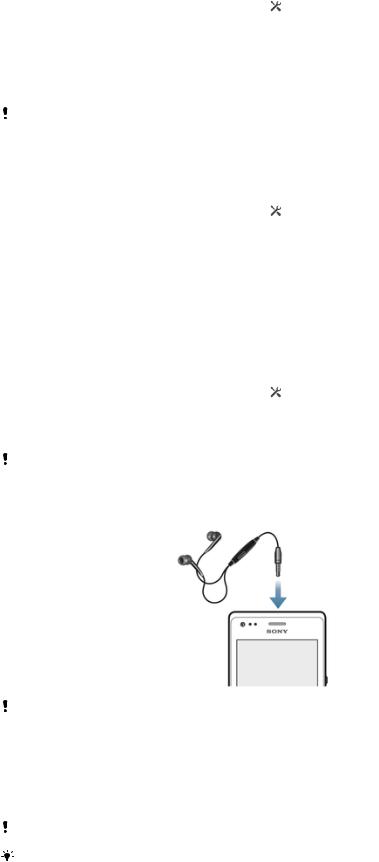
To unmount the memory card
1 Drag the status bar downwards, then tap .
2Find and tap Storage > Unmount SD card.
Formatting the memory card
You can format the memory card in your device, for example, to free up memory. This means that you erase all data on the card.
All content on the memory card gets erased when you format it. Make sure you make backups of everything you want to save before formatting the memory card. To back up your content, you can copy it to your computer. For more information, refer to the chapter Connecting your device to a computer on page 89.
To format the memory card
1 Drag the status bar downwards, then tap .
2Find and tap Storage > Erase SD card.
3To confirm, tap Erase SD card > Erase everything
Clearing the application memory
You may sometimes need to clear the memory for an application. This might happen if, for example, the application memory becomes full, or you want to clear scores for a game. You might also want to delete incoming email, text and multimedia messages in some applications.
To clear the memory for an application
1 Drag the status bar downwards, then tap .
2Find and tap Apps.
3 Tap the application for which you want to clear the memory.
4Tap Clear cache.
It is not possible to clear the memory for some applications.
Using a headset
Use the accessories provided with your device, or other compatible accessories, for optimal performance.
To use a headset
1Connect the headset to your device.
2 To answer a call, press the call handling key.
3To end the call, press the call handling key.
If a headset is not included with the device, you may purchase one separately.
If you are listening to music, the music stops when you answer a call and resumes after you end the call.
29
This is an Internet version of this publication. © Print only for private use.

Internet and messaging settings
To send multimedia messages, or to access the Internet when there is no available Wi-Fi® network, you must have a working mobile data connection with the correct Internet and messaging settings. Here are some tips:
•For most mobile networks and operators, Internet and messaging settings come preinstalled on your device. You can then start using the Internet and send multimedia messages right away.
•In some cases, you get the option to download Internet and messaging settings the first time you turn on your device when a SIM card is inserted. It is also possible to download these settings later from the Settings menu.
•You can manually add, change or delete Internet and messaging settings on your device at any time. Contact your network operator for detailed information.
Sometimes you need to wait a while to have a working mobile data connection, especially when the signal strength is weak and unstable. To increase the signal strength from your mobile network, move to an open location free from obstructions or get close to a window.
To download Internet and messaging settings
1 From your Home screen, tap .
2Find and tap Settings > More… > Internet settings.
3Select the SIM card, or SIM cards, for which you want to download Internet and messaging settings.
4Tap Accept.  appears in the status bar once the settings have been downloaded successfully.
appears in the status bar once the settings have been downloaded successfully.
If the settings cannot be downloaded to your device, check the signal strength of your mobile network. Move to an open location free from obstructions or get close to a window and then try again.
To reset the default Internet settings
1 Drag the status bar downwards, then tap .
2Tap More… > Mobile networks.
3 Select the SIM card for which you want to reset the settings.
4 Tap Access Point Names, then tap .
5Tap Reset to default.
Access Point Names (APNs)
An APN is used to establish data connections between your device and the Internet. The APN defines which type of IP address to use, which security methods to invoke, and which fixed-end connections to use. Checking the APN is useful when you cannot access the Internet, have no data connection, or cannot send or receive multimedia messages.
To view the current Access Point Name (APN)
1 From your Home screen, tap .
2Find and tap Settings > More… > Mobile networks.
3 Select the SIM card for which you want to view the APN.
4Tap Access Point Names.
If you have several available connections, the active network connection is indicated by a marked button  .
.
30
This is an Internet version of this publication. © Print only for private use.
